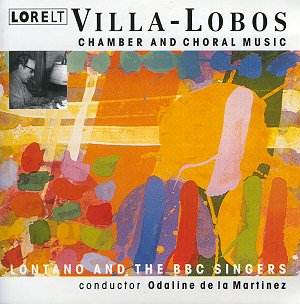Given that he was a hugely prolific composer, writing
at that point of the twentieth century before rampant modernism began
to scare audiences away, and that his output covers almost every conceivable
genre and style, it is surprising that Heitor Villa-Lobos should not
be more of a household name than he is. The famous Bachianas Brasilieras
No 5 for soprano and eight cellos is the only work to have become Classic
FM recognisable. Fortunately, this excellent disc of chamber music
performed by the BBC Singers and the flexible instrumental group Lontano
opts for a performance of the rather more interesting Bachianas Brasilieras
No 9, written in 1945. This choral showpiece really exposes the links
that Villa-Lobos was making between the musical idioms of his native
Brazil and the structural and intellectual precepts of the music of
his hero, Bach. The fugue in particular is a tightly wrought compositional
exercise, but the Brazilian rhythmic flavours permeate the whole. The
BBC Singers, under the direction of Odaline de la Martinez, a great
champion of Latin and South American classical music, sing this with
the tightness of ensemble and the easy virtuosity that one would expect
from such a professional group. The result is instantly engaging, and
yet not without intellectual stimulation. A good combination.
The only other work on this disc to make any use of
voices is the Quatuor from 1921. This is a fascinating work scored for
flute, alto saxophone, celesta, harp and female voices (not really a
quartet at all then). This is about as far in terms of timbre as it
can get from the traditional quartet of strings and the performers here
utilise this wonderfully colourful palette well. The female voices,
as in the famous Bachianas Brasilieras No 5, are entirely without words;
the voice used as a pure instrument. The voices, together with the celesta
and the harp give a strangely otherworldly quality and the effect is
wonderful. The same ideas are apparent in the opening Sesteto Místico
composed in 1917. While this is a most engaging work full of impressionist
colours and harmonies, the mystic effect is not as fully worked out
as in Quatuor. The composition occupies more of the sound world of Ravel,
as indeed do the Two Chôros bis. This work for violin and cello
makes much use of Ravel-esque rhythmic, almost percussive, string writing.
The composition is so skilful that most of the piece sounds like it
is for string quartet rather than merely duo.
Lontano is a flexible group of highly skilled musicians
and their performances on this disc are both evocative and memorable.
The programming is interesting and varied and bears repeated listening.
There is in Villa-Lobos something at the same time familiar and different.
His music really does deserve to be better known and more widely appreciated.
This disc is a good place to start.
Peter Wells


